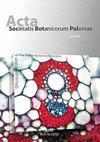中亚吉尔吉斯斯坦天山西部高寒草地的分类
IF 0.8
4区 生物学
Q3 PLANT SCIENCES
引用次数: 1
摘要
本文首次提出了吉尔吉斯斯坦天山西部高寒草地的分类学分类,并对其环境梯度作了评述。2015-2022年,使用布劳恩-布兰凯方法的7度覆盖丰度量表,对251个相关的渡口进行了抽样。使用欧几里得距离度量的聚集分层Ward方法对这些进行分类。诊断种采用<i>phi</i>作为保真度度量的系数。NMDS被用来探索不同群体之间的关系。我们的分类揭示了中亚高寒草地的13个生态意义集群,对应于12个关联和1个无秩单位。这些新群落已被纳入三个新联盟:<i>乌头草(Aconito rotundifolii-Potentillion pamiroalicae) </i>-天山西部的亚高山和高山杂交种草甸和牧场,以及中亚亚高山的灌木状喜风荒地,<- & lt; i> Kobresia< / i>草席和<i>松茸</i>-亚高山草木草原植被。区分研究植被种类组成的主要气候因子是温度季节性、平均日较差和年降水量总和。其中最重要的土壤因子是pH、阳离子交换量和氮有效性。我们的研究扩大了对帕米尔阿莱受伊朗-图兰气候影响的植被与天山高寒带草地植被交界地带的高寒草地的认识。它们的最终分类当然还需要进一步的研究和比较,特别是与阿尔泰地区的高山草原和一些与喀喇昆仑-喜马拉雅山脉密切相关的植被单位进行比较。本文章由计算机程序翻译,如有差异,请以英文原文为准。
Classification of alpine grasslands in the western Tian Shan Mountains (Kyrgyzstan, Middle Asia)
In this paper, we present the first syntaxonomic classification of alpine grasslands in the western Tian Shan Mountains (Kyrgyzstan) with some remarks on its environmental gradients. A total of 251 relevés were sampled in 2015-2022 using the seven-degree cover-abundance scale of the Braun-Blanquet approach. These were classified using the agglomerative hierarchical Ward’s method employing the Euclidean distance measure. Diagnostic species were identified using the phi coefficient as a fidelity measure. NMDS was used to explore the relationships between the distinguished groups. Our classification revealed 13 ecologically meaningful clusters corresponding to 12 associations and one rankless unit of alpine grasslands in Middle Asia. The new communities have been included in three new alliances: Aconito rotundifolii-Potentillion pamiroalaicae – subalpine and alpine mesic forb meadows and pastures in the western Tian Shan and shrubby subalpine chionophilous heaths of Middle Asia, Stipo regelianae-Ptilagrostion malyschevii – Kobresia mats and Artemision dracunculi – subalpine forb steppe vegetation. The main climatic factors differentiating the species composition of the researched vegetation are temperature seasonality, mean diurnal temperature range and a sum of annual precipitation. Among the soil factors the most important are pH, cation exchange capacity and nitrogen availability. Our study has expanded the knowledge of the alpine grasslands on the borderland between vegetation influenced by Irano-Turanian climate in Pamir-Alai and grassland vegetation of the alpine belt in Tian Shan. Their final classification certainly still requires further studies and comparisons, especially with the Alpine grasslands in the Altai region and some of the vegetation units closely related to Karakorum-Himalayan ranges.
求助全文
通过发布文献求助,成功后即可免费获取论文全文。
去求助
来源期刊
CiteScore
2.00
自引率
10.00%
发文量
18
审稿时长
1 months
期刊介绍:
The journal has been published since 1923 and offers Open Access publication of original research papers, short communications, and reviews in all areas of plant science, including evolution, ecology, genetics, plant structure and development, physiology and biochemistry.

 求助内容:
求助内容: 应助结果提醒方式:
应助结果提醒方式:


